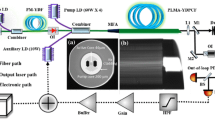A device for measurements of phase noise with the use of the Mach–Zehnder interferometer is proposed, in which all fi ber components are made based on fiber with polarization state maintenance. This permits not using a basic radiation source in the device, and thereby reducing significantly the installation cost. Two interference signals from orthogonally polarized waves are formed in the device and are then divided by a polarizing demultiplexor that eliminates the effect of external noise on the measurement result. An algorithm for calculating phase noise is described and an estimate of the effect of temperature instability is presented. A comparison of the characteristics of phase noise between calculated and specified in modeling was performed in order to assess the operational capability of the installation and algorithm for signal processing.




Similar content being viewed by others
References
R. Paschotta, Encyclopedia of Laser Physics and Technology, Wiley, Berlin (2008), Vol. 1.
D. G. Grishin and V. I. Teleshevskii, “Analysis of phase noise in heterodyne interferometry with acousto-optical transformation of light frequency,” Izmer. Tekhn., No. 1, 17–21 (2014).
Y. Wang, B. Jin, Y. Wang, et al., “Real-time distributed vibration monitoring system using Phi-OTDR,” IEEE Sensors J., 17, No. 5, 1333–1341 (2017).
A. Pniov, A. Zhirnov, D. Shelestov, et al., “Yb, Er: glass microlaser at 1.5 μm for optical fi ber sensing: Development, characterization and noise reduction,” Acta IMEKO, 5, No. 4, 24–28 (2016).
A. K. Fedorov, M. N. Anufriev, A. A. Zhirnov, et al., “Note: Gaussian mixture model for event recognition in optical time-domain reflectometry based sensing systems,” Rev. Sci. Instrum., 87, No. 3, 036107 (2016), DOI: https://doi.org/10.1063/1.4944417.
A. V. Makarenko, “Deep learning algorithms for signal recognition in long perimeter monitoring distributed fiber optic sensors,” Machine Learning for Signal Processing (MLSP): IEEE 26th Int. Workshop, Vietri sul Mare (2016), pp. 1–6, DOI: https://doi.org/10.1109/MLSP.2016.7738863.
K. J. Williams, A. Dandridge, A. D. Kersey, et al., “Interferometric measurement of low-frequency phase noise characteristics of diode laser-pumped Nd: YAG ring laser,” Electronics Lett., 25, 774–776 (1989), DOI: https://doi.org/10.1049/el:19890523.
Z. Meng, Y. Hu, S. Xiong, et al., “Phase noise characteristics of a diode-pumped Nd:YAG laser in an unbalanced fiber-optic interferometer,” Appl. Opt., 44, No. 17, 3425–3428 (2005), DOI: https://doi.org/10.1364/AO.44.004525.
A. B. Pnev, K. V. Stepanov, D. A. Dvoretskii, et al., “Minimization of errors in narrowband laser phase noise measurements based on reference measurement channels,” Int. J. Adv. Biotech. Res., 7, No. 4, 1445–1451 (2016).
Author information
Authors and Affiliations
Corresponding author
Additional information
Translated from Izmeritel’naya Tekhnika, No. 5, pp. 37–42, May, 2018.
Rights and permissions
About this article
Cite this article
Pnev, A.B., Borisova, A.V., Denisova, Y.A. et al. Minimizing Measurement Error of Phase Noise of a Narrow-Band Laser Using a Fiber-Based Mach–Zehnder Interferometer with Polarization Maintenance. Meas Tech 61, 467–473 (2018). https://doi.org/10.1007/s11018-018-1453-y
Received:
Published:
Issue Date:
DOI: https://doi.org/10.1007/s11018-018-1453-y




